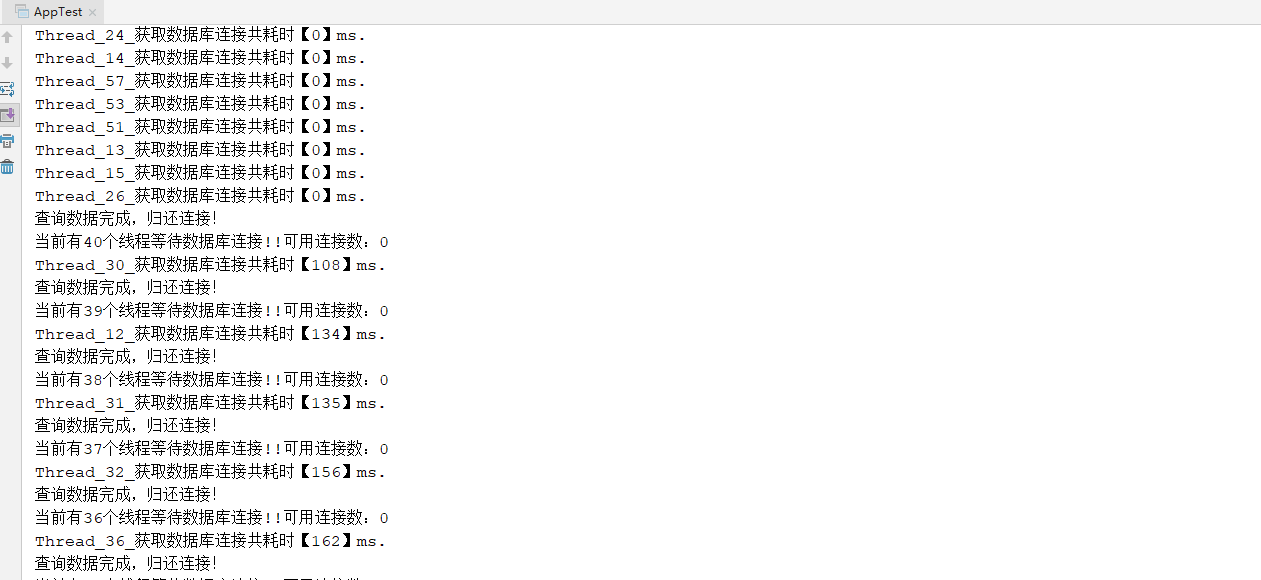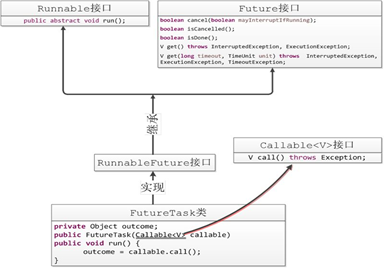Semaphore
基本概念:
Semaphore(信号量)是用来控制同时访问特定资源的线程数量,它通过协调各个线程,以保证合理的使用公共资源。
使用场景:
Semaphore可以用于做流量控制,特别是公用资源有限的应用场景,比如数据库连接。
假如有一个需求,要读取几万个文件的数据,因为都是IO密集型任务,我们可以启动几十个线程并发地读取,但是如果读到内存后,还需要存储到数据库中,而数据库的连接数只有10个,这时我们必须控制只有10个线程同时获取数据库连接保存数据,否则会报错无法获取数据库连接。这个时候,就可以使用Semaphore来做流量控制。
Semaphore的构造方法Semaphore(int permits)接收一个整型的数字,表示可用的许可证数量。Semaphore的用法也很简单,首先线程使用Semaphore的acquire()方法获取一个许可证,使用完之后调用release()方法归还许可证。还可以用tryAcquire()方法尝试获取许可证。
Semaphore还提供一些其他方法,具体如下:
- intavailablePermits():返回此信号量中当前可用的许可证数。
- intgetQueueLength():返回正在等待获取许可证的线程数。
- booleanhasQueuedThreads():是否有线程正在等待获取许可证。
- void reducePermits(int reduction):减少reduction个许可证,是个protected方法。
- Collection getQueuedThreads():返回所有等待获取许可证的线程集合,是个protected方法。
图解:

数据库连接配置:
import java.sql.*;
import java.util.Map;
import java.util.Properties;
import java.util.concurrent.Executor;
/**
* @author monco
* @date 2020/5/20
* @description: 实现数据库连接接口
*/
public class SqlConnectImpl implements Connection {
/*拿一个数据库连接*/
public static final Connection fetchConnection() {
return new SqlConnectImpl();
}
@Override
public Statement createStatement() throws SQLException {
return null;
}
@Override
public PreparedStatement prepareStatement(String sql) throws SQLException {
return null;
}
@Override
public CallableStatement prepareCall(String sql) throws SQLException {
return null;
}
@Override
public String nativeSQL(String sql) throws SQLException {
return null;
}
@Override
public void setAutoCommit(boolean autoCommit) throws SQLException {
}
@Override
public boolean getAutoCommit() throws SQLException {
return false;
}
@Override
public void commit() throws SQLException {
}
@Override
public void rollback() throws SQLException {
}
@Override
public void close() throws SQLException {
}
@Override
public boolean isClosed() throws SQLException {
return false;
}
@Override
public DatabaseMetaData getMetaData() throws SQLException {
return null;
}
@Override
public void setReadOnly(boolean readOnly) throws SQLException {
}
@Override
public boolean isReadOnly() throws SQLException {
return false;
}
@Override
public void setCatalog(String catalog) throws SQLException {
}
@Override
public String getCatalog() throws SQLException {
return null;
}
@Override
public void setTransactionIsolation(int level) throws SQLException {
}
@Override
public int getTransactionIsolation() throws SQLException {
return 0;
}
@Override
public SQLWarning getWarnings() throws SQLException {
return null;
}
@Override
public void clearWarnings() throws SQLException {
}
@Override
public Statement createStatement(int resultSetType, int resultSetConcurrency) throws SQLException {
return null;
}
@Override
public PreparedStatement prepareStatement(String sql, int resultSetType, int resultSetConcurrency) throws SQLException {
return null;
}
@Override
public CallableStatement prepareCall(String sql, int resultSetType, int resultSetConcurrency) throws SQLException {
return null;
}
@Override
public Map<String, Class<?>> getTypeMap() throws SQLException {
return null;
}
@Override
public void setTypeMap(Map<String, Class<?>> map) throws SQLException {
}
@Override
public void setHoldability(int holdability) throws SQLException {
}
@Override
public int getHoldability() throws SQLException {
return 0;
}
@Override
public Savepoint setSavepoint() throws SQLException {
return null;
}
@Override
public Savepoint setSavepoint(String name) throws SQLException {
return null;
}
@Override
public void rollback(Savepoint savepoint) throws SQLException {
}
@Override
public void releaseSavepoint(Savepoint savepoint) throws SQLException {
}
@Override
public Statement createStatement(int resultSetType, int resultSetConcurrency, int resultSetHoldability) throws SQLException {
return null;
}
@Override
public PreparedStatement prepareStatement(String sql, int resultSetType, int resultSetConcurrency, int resultSetHoldability) throws SQLException {
return null;
}
@Override
public CallableStatement prepareCall(String sql, int resultSetType, int resultSetConcurrency, int resultSetHoldability) throws SQLException {
return null;
}
@Override
public PreparedStatement prepareStatement(String sql, int autoGeneratedKeys) throws SQLException {
return null;
}
@Override
public PreparedStatement prepareStatement(String sql, int[] columnIndexes) throws SQLException {
return null;
}
@Override
public PreparedStatement prepareStatement(String sql, String[] columnNames) throws SQLException {
return null;
}
@Override
public Clob createClob() throws SQLException {
return null;
}
@Override
public Blob createBlob() throws SQLException {
return null;
}
@Override
public NClob createNClob() throws SQLException {
return null;
}
@Override
public SQLXML createSQLXML() throws SQLException {
return null;
}
@Override
public boolean isValid(int timeout) throws SQLException {
return false;
}
@Override
public void setClientInfo(String name, String value) throws SQLClientInfoException {
}
@Override
public void setClientInfo(Properties properties) throws SQLClientInfoException {
}
@Override
public String getClientInfo(String name) throws SQLException {
return null;
}
@Override
public Properties getClientInfo() throws SQLException {
return null;
}
@Override
public Array createArrayOf(String typeName, Object[] elements) throws SQLException {
return null;
}
@Override
public Struct createStruct(String typeName, Object[] attributes) throws SQLException {
return null;
}
@Override
public void setSchema(String schema) throws SQLException {
}
@Override
public String getSchema() throws SQLException {
return null;
}
@Override
public void abort(Executor executor) throws SQLException {
}
@Override
public void setNetworkTimeout(Executor executor, int milliseconds) throws SQLException {
}
@Override
public int getNetworkTimeout() throws SQLException {
return 0;
}
@Override
public <T> T unwrap(Class<T> iface) throws SQLException {
return null;
}
@Override
public boolean isWrapperFor(Class<?> iface) throws SQLException {
return false;
}
}
** Semaphore 进行限流使用:**
import java.sql.Connection;
import java.util.LinkedList;
import java.util.concurrent.Semaphore;
/**
* @author : monco
* @date : 2019/10/11 1:46
* className: DBPoolSemaphore
* description: Semaphore 进行限流使用
*/
public class DBPoolSemaphore {
private final static int POOL_SIZE = 10;
/**
* 两个指示器,分别表示池子还有可用连接和已用连接
*/
private final Semaphore useful, useless;
/**
* 创建存储连接的容器
*/
private static LinkedList<Connection> pool = new LinkedList<Connection>();
/**
* 初始化连接池
*/
static {
for (int i = 0; i < POOL_SIZE; i++) {
pool.addLast(SqlConnectImpl.fetchConnection());
}
}
public DBPoolSemaphore() {
this.useful = new Semaphore(10);
this.useless = new Semaphore(0);
}
/**
* 归还连接
*
* @param connection
* @throws InterruptedException
*/
public void returnConnect(Connection connection) throws InterruptedException {
if (connection != null) {
System.out.println("当前有" + useful.getQueueLength() + "个线程等待数据库连接!!"
+ "可用连接数:" + useful.availablePermits());
useless.acquire();
synchronized (pool) {
pool.addLast(connection);
}
useful.release();
}
}
/**
* 获取连接
*
* @return
* @throws InterruptedException
*/
public Connection takeConnect() throws InterruptedException {
useful.acquire();
Connection connection;
synchronized (pool) {
connection = pool.removeFirst();
}
useless.release();
return connection;
}
}
** 测试类:**
import java.sql.Connection;
import java.util.Random;
/**
* 类说明:测试数据库连接池
*/
public class AppTest {
private static DBPoolSemaphore dbPool = new DBPoolSemaphore();
private static class BusiThread extends Thread {
@Override
public void run() {
//让每个线程持有连接的时间不一样
Random r = new Random();
long start = System.currentTimeMillis();
try {
Connection connect = dbPool.takeConnect();
System.out.println("Thread_" + Thread.currentThread().getId()
+ "_获取数据库连接共耗时【" + (System.currentTimeMillis() - start) + "】ms.");
//模拟业务操作,线程持有连接查询数据
SleepTools.ms(100 + r.nextInt(100));
System.out.println("查询数据完成,归还连接!");
dbPool.returnConnect(connect);
} catch (InterruptedException e) {
e.printStackTrace();
}
}
}
public static void main(String[] args) {
for (int i = 0; i < 50; i++) {
Thread thread = new BusiThread();
thread.start();
}
}
}
** 运行结果:**

Callable、Future和FutureTask
我们在创建的线程的时候,在实现Runnable的时候,因为Runnable是一个接口,在它里面只声明了一个run()方法,由于run()方法返回值为void类型,所以在执行完任务之后无法返回任何结果。
Callable位于java.util.concurrent包下,它也是一个接口,在它里面也只声明了一个方法,只不过这个方法叫做call(),这是一个泛型接口,call()函数返回的类型就是传递进来的V类型。
Future就是对于具体的Runnable或者Callable任务的执行结果进行取消、查询是否完成、获取结果。必要时可以通过get方法获取执行结果,该方法会阻塞直到任务返回结果。
因为Future只是一个接口,所以是无法直接用来创建对象使用的,因此就有了下面的FutureTask。
FutureTask类实现了RunnableFuture接口,RunnableFuture继承了Runnable接口和Future接口,而FutureTask实现了RunnableFuture接口。所以它既可以作为Runnable被线程执行,又可以作为Future得到Callable的返回值。

因此我们通过一个线程运行Callable,但是Thread不支持构造方法中传递Callable的实例,所以我们需要通过FutureTask把一个Callable包装成Runnable,然后再通过这个FutureTask拿到Callable运行后的返回值。
要new一个FutureTask的实例,有两种方法

import java.util.Random;
import java.util.concurrent.Callable;
import java.util.concurrent.ExecutionException;
import java.util.concurrent.FutureTask;
/**
* @author : monco
* @date : 2019/10/11 1:46
* className: UseFuture
* description: 实现future
*/
public class UseFuture {
/**
* 实现 Callable接口,允许有返回值
*/
private static class UseCallable implements Callable<Integer> {
private int sum;
@Override
public Integer call() throws Exception {
System.out.println("Callable子线程开始计算!");
Thread.sleep(1000);
for (int i = 0; i < 5000; i++) {
if (Thread.currentThread().isInterrupted()) {
System.out.println("Callable子线程计算任务中断!");
return null;
}
sum = sum + i;
System.out.println("sum=" + sum);
}
System.out.println("Callable子线程计算结束!结果为: " + sum);
return sum;
}
}
public static void main(String[] args)
throws InterruptedException, ExecutionException {
UseCallable useCallable = new UseCallable();
//包装
FutureTask<Integer> futureTask = new FutureTask<>(useCallable);
Random r = new Random();
new Thread(futureTask).start();
Thread.sleep(1);
if (r.nextInt(100) > 50) {
System.out.println("Get UseCallable result = " + futureTask.get());
} else {
System.out.println("Cancel................. ");
futureTask.cancel(true);
}
}
}